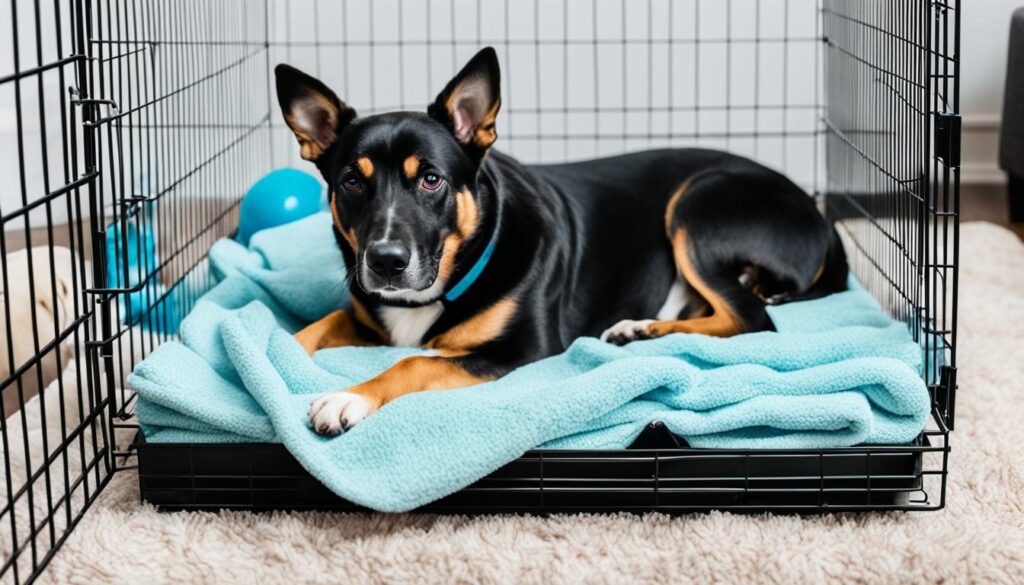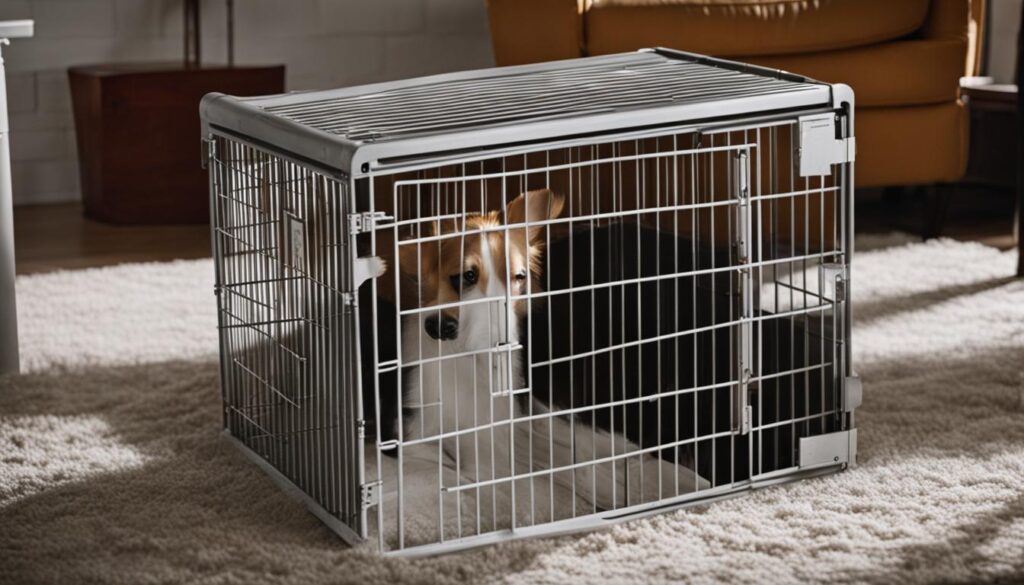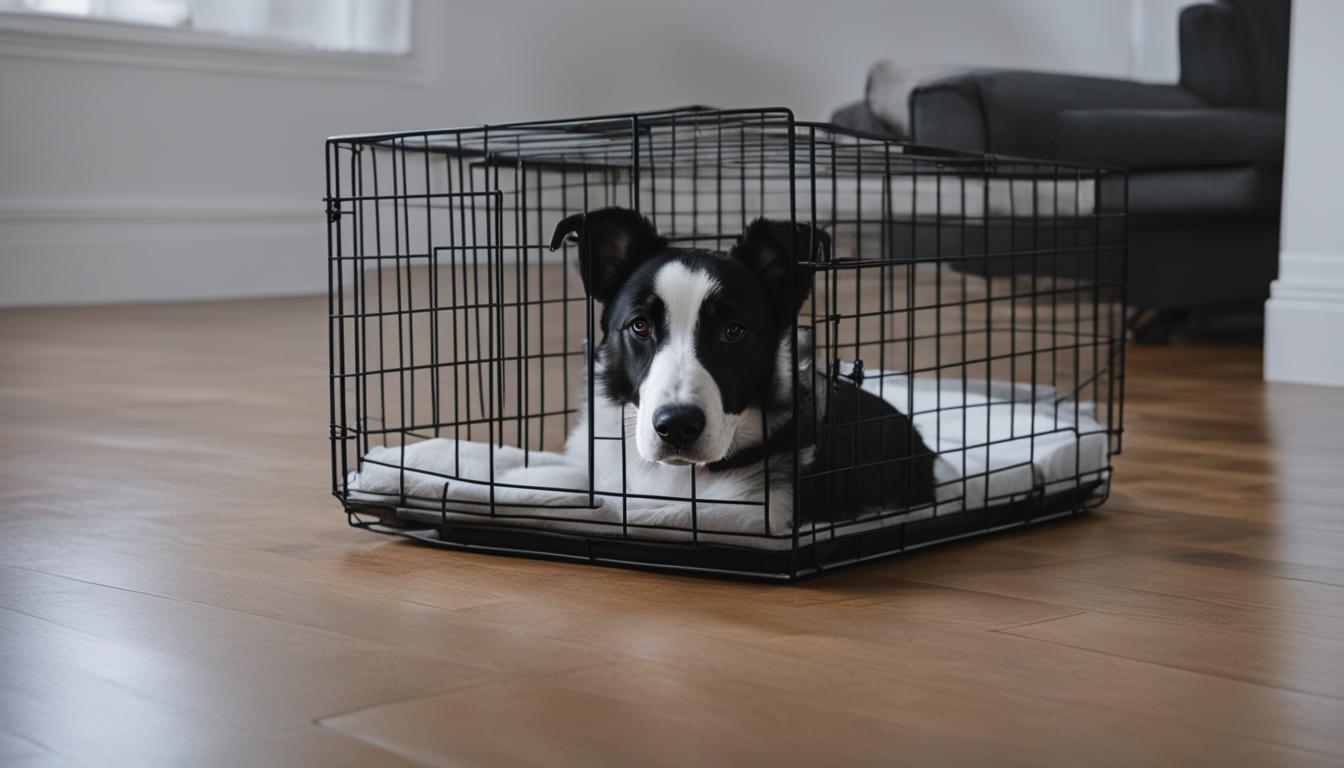As a responsible pet owner, ensuring the well-being of your dog is a top priority. Sometimes, dogs may require the use of a cone to prevent them from licking, scratching, or biting at wounds or irritations. But can a dog wear a cone in a crate?
The answer is yes, a dog can wear a cone in a crate, but it's essential to follow safe practices to ensure the dog's comfort and safety. When using a cone in a crate, it's crucial to choose the right size cone and crate and to monitor the dog closely to prevent any potential problems. Let's explore the safe practices of using a dog cone in a crate.
As an Amazon Associate, we earn from qualifying purchases
Key Takeaways: Can A Dog Wear A Cone In A Crate
- It is possible for a dog to wear a cone in a crate.
- The cone should be properly fitted and not restrict the dog's movement.
- Regular monitoring is necessary to ensure the cone doesn't get caught on the crate.
- Cones can protect wounds, surgical sites, and prevent chewing on bandages or stitches.
- Choose the right size crate, monitor the dog closely, and provide a comfortable environment for a dog wearing a cone in a crate.
Last update on 2025-06-21 / Affiliate links / Images from Amazon Product Advertising API
Benefits of Using a Dog Cone in a Crate
Using a dog cone in a crate can provide various benefits for the well-being of your furry companion. Let's take a closer look at why incorporating a cone can be advantageous for managing dog behavior and promoting healing.
1. Prevents Scratching and Further Injury
A dog cone, often humorously referred to as the “cone of shame,” is a reliable tool for preventing dogs from scratching wounds or surgical sites. By creating a physical barrier, the cone effectively protects these areas from further harm.
2. Protects Bandages and Stitches
Cones are especially useful in preventing dogs from chewing on bandages or stitches. By wearing a cone, your four-legged friend won't be able to access these areas, facilitating faster and more comfortable healing.
3. Acts as a Barrier Against Licking and Bacteria
The cone serves as a barrier between your dog's mouth and the wound, preventing the harmful licking that can introduce bacteria and delay the healing process. By eliminating contact, the cone aids in maintaining clean and infection-free wounds.
4. Prevents Scratching of Ears and Eyes
In addition to protecting wounds, cones also prevent dogs from scratching itchy ears or rubbing sensitive eyes. This is particularly important for dogs with allergies or other conditions that may cause discomfort in these areas.
5. Easy to Use and Adjust
Cones are designed to be user-friendly and can be easily adjusted or removed as needed. This flexibility allows for quick access to wounds during check-ups or medication administration without causing undue stress or discomfort to your pet.
Using a dog cone in a crate provides a practical solution for most dog owners. Veterinary professionals often recommend utilizing cones to manage wounds or surgical sites effectively. By incorporating a cone in your dog's crate, you can ensure their safety and promote a smooth healing process.


Tips for Using a Dog Cone in a Crate
When it comes to using a dog cone in a crate, there are a few important tips to keep in mind. Ensuring a safe and comfortable experience for your furry friend is essential. Here are some practical guidelines to help you manage a dog cone in a crate effectively:
1. Ensure Adequate Crate Size
Make sure that the crate is spacious enough for your dog to move comfortably with the cone on. A confined space can lead to discomfort and agitation.
2. Remove Potential Obstacles
Remove any toys or bedding that can get stuck in the cone or impede your dog's movement. This will prevent accidents and keep your dog safe.
3. Consider Food and Water Access
Take into account if your dog can access food and water easily with the cone on. If necessary, adjust the crate placement or provide accommodations to ensure your dog stays hydrated and nourished.
4. Regularly Check on Your Dog
Regularly check on your dog to ensure both their comfort and that the cone is properly in place. Look for any signs of discomfort or irritation and make any necessary adjustments.
5. Provide a Larger Sleeping Space
Give your dog a larger sleeping space within the crate to accommodate the cone. This will provide more comfort and allow them to rest without feeling confined.
6. Soften the Cone if Needed
If your dog seems uncomfortable with the cone, try softening it by adding padding or wrapping it with a soft fabric. This can help alleviate any pressure or scratching sensations.
7. Adjust Bedding and Keep Your Dog Mentally Stimulated
Ensure that your dog's bedding is comfortable, and consider adding extra padding for added support. Additionally, keep your dog mentally stimulated with interactive toys or puzzles to help distract them from the discomfort of the cone.
By following these tips, you can effectively manage a dog cone in a crate, ensuring your pet's well-being during the healing process.


| BenefitsConsiderationsPrevents licking, scratching, and biting at wounds or irritationsProper crate size is essential for comfortProtects wounds and surgical sitesRemove potential obstaclesPrevents chewing on bandages or stitchesEnsure food and water accessComfort and support during the healing processRegularly check on your dog's comfortBarrier between the dog's mouth and the woundProvide a larger sleeping space |
|---|
Conclusion
Dogs can safely wear cones in crates, making crate training a cone-friendly option for managing and protecting wounds or surgical sites. However, it is crucial to take necessary precautions to prevent further injury and ensure the well-being of your furry friend.
First and foremost, make sure the crate is large enough for the dog to move comfortably with the cone on. This ensures that they can turn around, lie down, and sit without any restrictions. Additionally, properly fitting the cone is essential to prevent discomfort or rubbing against the crate, which can lead to irritation or injury.
Another consideration is the crate itself. Sharp edges or corners inside the crate should be covered to avoid accidents with the cone. Providing a safe and secure environment is vital to prevent any mishaps and allow for successful crate training with a cone.
Monitoring your dog closely while they are crated is also important. This ensures that they are not causing harm to themselves or attempting to remove the cone. Confinement in a crate should be limited to avoid physical and psychological health issues, and regular breaks should be provided to allow for exercise, mental stimulation, and social interaction.
With proper care and attention, crate training for dogs with cones can be an effective way to manage and protect wounds or surgical sites. By following these guidelines and prioritizing the well-being of your furry companion, you can ensure a positive and successful crate training experience.
FAQ
Can a dog wear a cone in a crate?
Yes, a dog can wear a cone in a crate as long as it is large enough and doesn't restrict the dog's movement. However, the dog may have trouble turning around or sitting comfortably. It is important to properly fit the cone and ensure there is enough clearance to prevent it from getting caught on the crate.
What are the benefits of using a dog cone in a crate?
Using a dog cone in a crate can prevent the dog from scratching at wounds or surgical sites and protect them from further injury. Cones can also prevent dogs from chewing on bandages or stitches and promote faster and more comfortable healing. The cone acts as a barrier between the dog's mouth and the wound, preventing licking and introducing bacteria. It can also prevent dogs from scratching itchy ears or rubbing sensitive eyes.
What are some tips for using a dog cone in a crate?
When using a dog cone in a crate, make sure the crate is large enough for the dog and the cone. Remove any toys or bedding that can get stuck in the cone or hinder the dog's movement. Consider if the dog can access food and water with the cone on, and make necessary accommodations if needed. Regularly check on the dog to ensure their comfort and that the cone is properly in place. Provide a larger sleeping space and soften the cone if needed. Adjust the dog's bedding and keep them mentally stimulated to distract them from the discomfort of the cone.
Can a dog in a crate with a cone cause harm to itself?
While dogs can safely wear cones in crates, precautions need to be taken to avoid further injury. The crate should be large enough for the dog to move comfortably with the cone on. The cone should fit properly and not cause discomfort or rub against the crate. Sharp edges or corners inside the crate should be covered to prevent any accidents with the cone. Dogs should be monitored closely while crated to ensure they are not causing harm to themselves or attempting to remove the cone. Confinement in a crate should be limited to avoid physical and psychological health issues.
Can I use alternative devices instead of a traditional cone in a crate?
Yes, there are alternatives to traditional plastic cones that can be used in a crate. Soft cones, inflatable collars, and bite-not collars are available options. These alternatives can be more comfortable for the dog and allow for easier movement in the crate. However, it is important to ensure that the alternative device still effectively prevents the dog from licking or scratching at wounds or surgical sites.















